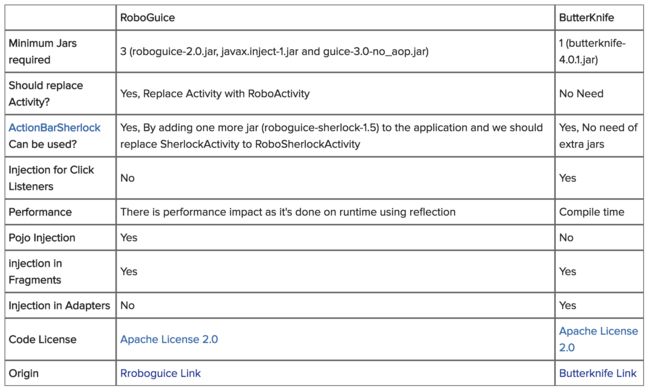本文总结并对比了三种Android依赖注入库:Butter Knife、RoboGuice、Android Annotations的使用
最近在研究一个开源项目Coding-Android Client,即Coding的安卓客户端,目前只看了小部分,但是感觉写得还是很赞的,学习到了很多的知识。因为这个项目是使用了Android Annotations的,看的时候虽然大致能明白各个注解是什么意思,但是感觉还是有必要详细了解下Android的各个依赖注入类库的功能特性和使用方式,于是便有了这篇总结。
目前而言,Android依赖注入类库比较火的主要有Butter Knife,RoboGuice,Android Annotations。(这里不考虑Dragger)
下面的导入方式都是指在使用Gradle的情况下进行的。
####1.Butter Knife
导入方式:compile 'com.jakewharton:butterknife:6.1.0'
毫无疑问,Butter Knife是这三者当中功能最简单的,详情可以查看这里。它主要功能就是注入View组件,使用方式如下:
class ExampleActivity extends Activity {
@InjectView(R.id.title) TextView title;
@InjectView(R.id.subtitle) TextView subtitle;
@InjectView(R.id.footer) TextView footer;
@Override public void onCreate(Bundle savedInstanceState) {
super.onCreate(savedInstanceState);
setContentView(R.layout.simple_activity);
ButterKnife.inject(this);
}
}
|
需要注意的是,它需要加上ButterKnife.inject(this);这句去执行注入操作。对于非Activity中可以使用ButterKnife.inject(this, view);来进行注入操作。
public class FancyFragment extends Fragment {
@InjectView(R.id.button1) Button button1;
@InjectView(R.id.button2) Button button2;
@Override public View onCreateView(LayoutInflater inflater, ViewGroup container, Bundle savedInstanceState) {
View view = inflater.inflate(R.layout.fancy_fragment, container, false);
ButterKnife.inject(this, view);
return view;
}
}
|
对于事件监听的注入,Butter Knife也提供了下面几种方式来操作:
@OnClick(R.id.submit)
public void submit(View view) {
}
@OnClick(R.id.submit)
public void submit() {
}
@OnClick(R.id.submit)
public void sayHi(Button button) {
button.setText("Hello!");
}
@OnClick({ R.id.door1, R.id.door2, R.id.door3 })
public void pickDoor(DoorView door) {
if (door.hasPrizeBehind()) {
Toast.makeText(this, "You win!", LENGTH_SHORT).show();
} else {
Toast.makeText(this, "Try again", LENGTH_SHORT).show();
}
}
|
####2.RoboGuice
导入方式:
compile 'org.roboguice:roboguice:3.+'
provided 'org.roboguice:roboblender:3.+'
|
大名鼎鼎的RoboGuice是Google的产物,功能自然是相当丰富的啦,基本上能使用注解的地方都支持了。基本的View注入、Resource注入、Service注入操作都很简单,代码如下所示:
@ContentView(R.layout.main)
class RoboWay extends RoboActivity {
@InjectView(R.id.name) TextView name;
@InjectView(R.id.thumbnail) ImageView thumbnail;
@InjectResource(R.drawable.icon) Drawable icon;
@InjectResource(R.string.app_name) String myName;
@Inject LocationManager loc;
public void onCreate(Bundle savedInstanceState) {
super.onCreate(savedInstanceState);
name.setText( "Hello, " + myName );
}
}
|
注意,它的重点在于需要继承自Robo*组件,例如Robo*Activities, RoboService、RoboIntentService和RoboContentProvider等等。除此之外呢,RoboGuice渗透到开发中的很多方面,例如它支持
(1)在TestCase中使用注入
(2)在自定义的View中使用注入
(3)在context-based events中使用注入
当然啦,这自然不是RoboGuice最大的亮点啦,我个人认为最大的亮点是对POJO的注入,就像Spring的依赖注入一样简单才行嘛。如下所示,Foo类的对象foo会被自动注入,所以我们就能够直接使用。当然啦,其实RoboGuice是通过调用了Foo的默认构造函数来得到这个foo实例的,不过RoboGuice还可以自定义使用哪个构造函数来生成这个注入的对象。
class MyActivity extends RoboActivity {
@Inject Foo foo;
}
|
除了上面的POJO注入之外,RoboGuice还提供了两个非常实用的注解@Singleton和@ContextSingleton。顾名思义,前者是在整个应用的生命周期中是单例,而后者是在对应的Context的生命周期中是单例。在使用的时候一定要考虑好对象的生命周期,因为使用不当的话容易导致内存泄露。
使用@Singleton的情况:
class MyActivity extends RoboActivity {
@Inject Foo foo;
}
@Singleton
class Foo {
}
new MyRoboActivity().foo = new MyRoboActivity().foo
|
使用@ContextSingleton的情况:
@ContextSingleton
class Foo {
}
public MyActivity extends RoboActivity {
@Inject Foo foo;
@Inject Bar bar;
}
public class Foo {
@Inject Bar bar;
}
@ContextSingleton
public class Bar {
}
new MyRoboActivity().foo != new MyRoboActivity().foo
MyRoboActivity a = new MyRoboActivity();
a.bar == a.foo.bar
|
RoboGuice 3.0添加了一个新的作用域FragmentSingleton
public MyFragment extends RoboFragment {
@Inject Foo foo;
@Inject Bar bar;
}
public class Foo {
@Inject Bar bar;
}
@FragmentSingleton
public class Bar {
}
myFragment.bar = myFragment.foo.bar
new MyFragment().bar = new MyFragment().foo.bar
|
关于RoboGuice和Butter Knife的对比
图片来源:dependency-injection-roboguice-butterknife

实现原理
RoboGuice是在运行时通过反射来实现的,而Butter Knife是在编译的时候就将代码转换好了的。下面的Android Annotations也是在编译的时候完成的,只不过对于每个采用注解增强了的组件类MyClass都会生成一个对应的组件类MyClass_。
####3.Android Annotations
导入方式:Building-Project-Gradle
buildscript {
repositories {
mavenCentral()
}
dependencies {
classpath 'com.android.tools.build:gradle:1.2.2'
classpath 'com.neenbedankt.gradle.plugins:android-apt:1.4'
}
}
repositories {
mavenCentral()
mavenLocal()
}
apply plugin: 'com.android.application'
apply plugin: 'android-apt'
def AAVersion = 'XXX'
dependencies {
apt "org.androidannotations:androidannotations:$AAVersion"
compile "org.androidannotations:androidannotations-api:$AAVersion"
}
apt {
arguments {
androidManifestFile variant.outputs[0].processResources.manifestFile
}
}
android {
compileSdkVersion 22
buildToolsVersion "22.0.1"
defaultConfig {
minSdkVersion 9
targetSdkVersion 22
}
}
|
很明显,Android Annotations的导入是最麻烦的,但是好在导入操作只是操作一次嘛,将就一下吧。从上面可以看出,Android Annotations是通过apt工具在编译时将MyClass转换成MyClass_的。此外,对于apt工具编译的过程还可以设置很多的参数,详细参数列表参见这里。
对于Android Annotations的功能,它基本上覆盖了Butter Knife和RoboGuice中的所有主要功能,详细的功能列表参见这里。下面是一个代码示例,实在是太强大了,大家感受下:
import java.util.Date;
import java.util.concurrent.TimeUnit;
import org.androidannotations.annotations.Background;
import org.androidannotations.annotations.Click;
import org.androidannotations.annotations.EActivity;
import org.androidannotations.annotations.LongClick;
import org.androidannotations.annotations.SystemService;
import org.androidannotations.annotations.Touch;
import org.androidannotations.annotations.Transactional;
import org.androidannotations.annotations.UiThread;
import org.androidannotations.annotations.ViewById;
import org.androidannotations.annotations.res.BooleanRes;
import org.androidannotations.annotations.res.ColorRes;
import org.androidannotations.annotations.res.StringRes;
import android.app.Activity;
import android.app.Notification;
import android.app.NotificationManager;
import android.app.PendingIntent;
import android.content.Intent;
import android.database.sqlite.SQLiteDatabase;
import android.os.Bundle;
import android.util.Log;
import android.view.MotionEvent;
import android.view.View;
import android.view.Window;
import android.view.WindowManager;
import android.widget.EditText;
import android.widget.TextView;
import android.widget.Toast;
@EActivity(R.layout.my_activity)
public class MyActivity extends Activity {
@ViewById
EditText myEditText;
@ViewById(R.id.myTextView)
TextView textView;
@StringRes(R.string.hello)
String helloFormat;
@ColorRes
int androidColor;
@BooleanRes
boolean someBoolean;
@SystemService
NotificationManager notificationManager;
@SystemService
WindowManager windowManager;
* AndroidAnnotations gracefully handles support for onBackPressed, whether you use ECLAIR (2.0), or pre ECLAIR android version.
*/
public void onBackPressed() {
Toast.makeText(this, "Back key pressed!", Toast.LENGTH_SHORT).show();
}
@Override
protected void onCreate(Bundle savedInstanceState) {
super.onCreate(savedInstanceState);
windowManager.getDefaultDisplay();
requestWindowFeature(Window.FEATURE_INDETERMINATE_PROGRESS);
}
@Click
void myButtonClicked() {
String name = myEditText.getText().toString();
setProgressBarIndeterminateVisibility(true);
someBackgroundWork(name, 5);
}
@Background
void someBackgroundWork(String name, long timeToDoSomeLongComputation) {
try {
TimeUnit.SECONDS.sleep(timeToDoSomeLongComputation);
} catch (InterruptedException e) {
}
String message = String.format(helloFormat, name);
updateUi(message, androidColor);
showNotificationsDelayed();
}
@UiThread
void updateUi(String message, int color) {
setProgressBarIndeterminateVisibility(false);
textView.setText(message);
textView.setTextColor(color);
}
@UiThread(delay = 2000)
void showNotificationsDelayed() {
Notification notification = new Notification(R.drawable.icon, "Hello !", 0);
PendingIntent contentIntent = PendingIntent.getActivity(this, 0, new Intent(), 0);
notification.setLatestEventInfo(getApplicationContext(), "My notification", "Hello World!", contentIntent);
notificationManager.notify(1, notification);
}
@LongClick
void startExtraActivity() {
Intent intent = ActivityWithExtra_.intent(this).myDate(new Date()).myMessage("hello !").get();
intent.putExtra(ActivityWithExtra.MY_INT_EXTRA, 42);
startActivity(intent);
}
@Click
void startListActivity(View v) {
startActivity(new Intent(this, MyListActivity_.class));
}
@Touch
void myTextView(MotionEvent event) {
Log.d("MyActivity", "myTextView was touched!");
}
@Transactional
int transactionalMethod(SQLiteDatabase db, int someParam) {
return 42;
}
}
|
How it works?
对于下面的使用E*(Enhance)注解的组件类,AA(Android Annotations)会在不同的源码目录下的相同包下生成一个对应的组件类。
package com.some.company;
@EActivity
public class MyActivity extends Activity {
}
package com.some.company;
public final class MyActivity_ extends MyActivity {
}
|
当我们在AndroidManifest.xml文件中注册Activity的时候需要注册后者
<activity android:name=".MyListActivity_" />
|
因为组件类变了,所以AA还提供了一套机制供开发者来构建Intent来实现组件跳转。
MyListActivity_.intent(context).start();
Intent intent = MyListActivity_.intent(context).get();
MyListActivity_.intent(context).flags(FLAG_ACTIVITY_CLEAR_TOP).start();
MyListActivity_.intent(context).myDateExtra(someDate).start();
MyListActivity_.intent(context).startForResult();
|
同样的,对于启动和绑定Service也有类似的机制
// Starting the service
MyService_.intent(context).start();
// Building an intent from the activity
Intent intent = MyService_.intent(context).build();
// You can provide flags
MyService_.intent(context).flags(Intent.FLAG_GRANT_READ_URI_PERMISSION).start();
|
Android Annotations其实还提供了很多其他的功能,例如它还能实现简单的Rest API、能注入选项菜单、能处理SQLite Transactions等等,需要了解的请看Android Annotations的详细文档吧。
OK,关于Android的依赖注入类库就介绍到这里吧,开发时具体选择哪个因人而异,也因项目而异,各有各的特点。Enjoy it!
转自:http://hujiaweibujidao.github.io/blog/2015/05/31/android-annotations/
